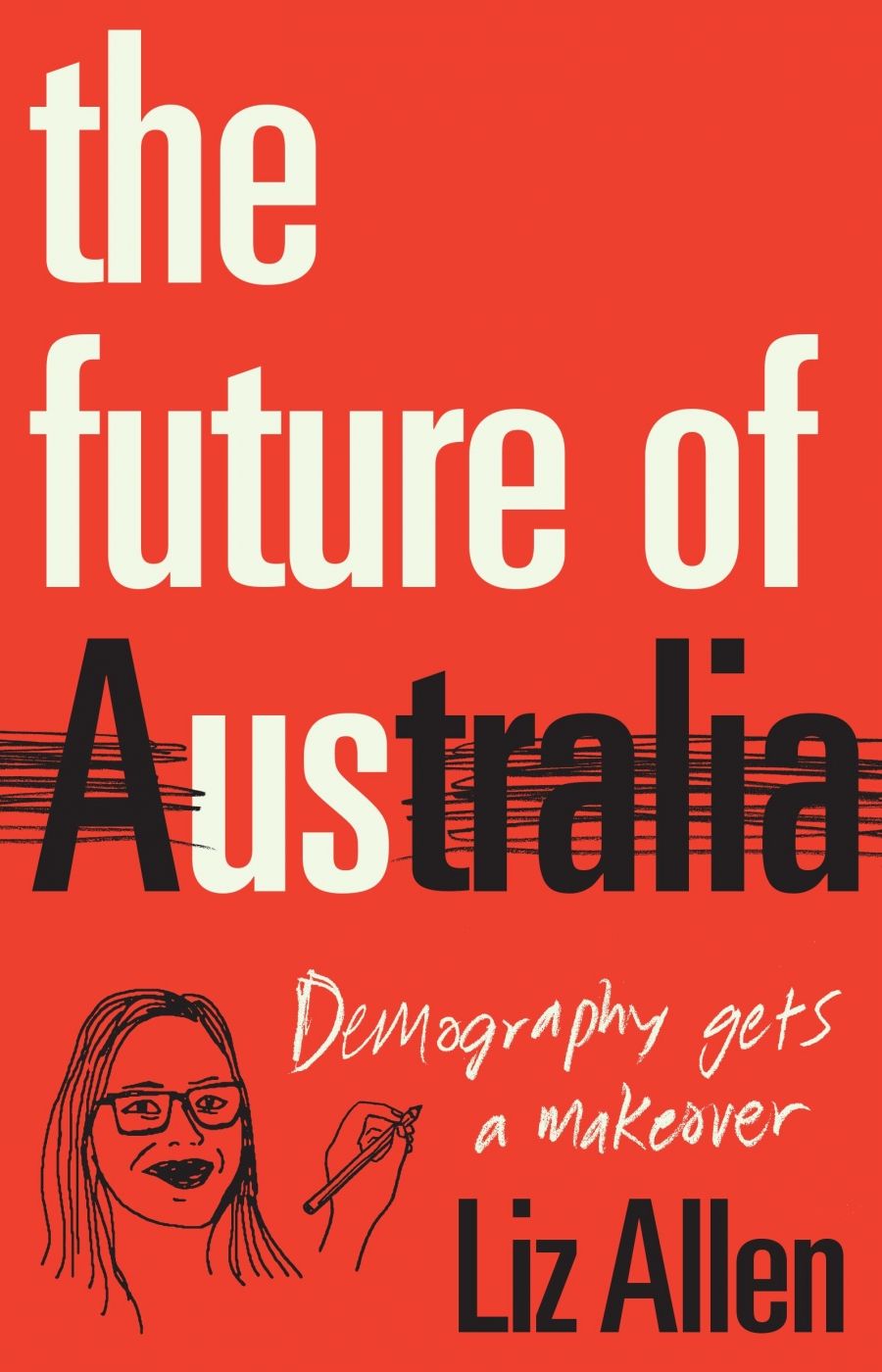
- Free Article: No
- Contents Category: Politics
- Review Article: Yes
- Custom Highlight Text:
In Australia, debate about population runs in well-worn grooves. The focus is on size – ‘big Australia’ versus ‘not-so-big Australia’ – and the tool used to regulate numbers is immigration. When politicians link population growth to excessive house prices, traffic congestion, unemployment, or crime, they call for immigration cuts, not for birth control.
- Grid Image (300px * 250px):

- Book 1 Title: The Future of Us
- Book 1 Subtitle: Demography gets a makeover
- Book 1 Biblio: NewSouth, $29.99 pb, 240 pp
First, there is demography’s effect on Allen’s own life. Traumatised by sexual abuse as a child, Allen attempted suicide as a teenager, dropped out of school, became homeless, and had her first baby at sixteen. Motherhood and a supportive relationship with the father (who is still Allen’s partner) brought focus and stability. At eighteen, she went to TAFE to finish high school; she went on to do a social science degree. Allen discovered demography through happenstance – it looked a less boring undergraduate elective than jurisprudence – but she was quickly hooked, not least because the subject helped make sense of her own life. Rather than seeing her difficult circumstances as a personal failing or a punishment from God, Allen came to understand that much of what happens to us is the result of luck or what she calls, borrowing from Warren Buffett, ‘the ovarian lottery’.
This leads to the second, larger view of demography as a superpower that can improve the lives of all Australians. Demography gives us the information to understand social problems and to build policies and institutions with a cradle-to-grave concern for well-being. Quality early-childhood education, for example, can serve as an ‘equaliser’ that gives children from disadvantaged families ‘a leg up on the ladder of life’, creating opportunities that more fortunate children might take for granted.
Allen’s passion for her topic is admirable, and The Future of Us is at its best when she is explaining her discipline and its complexities. She aims at a general audience with a conversational style that is easy to read but that can also grate, especially with its plethora of rhetorical questions, such as ‘I suspect you’re thinking: Well, so what?’ I wasn’t.
For Allen, the ‘true wonder of demography … is not its capacity to predict the future but to shape it’. She wants to use its superpowers to pursue a progressive agenda, but the book overreaches in placing too much weight on demographics as both cause of, and solution to, contemporary challenges. One of her major concerns, for example, is intergenerational wealth inequality. Demography can help define the contours of the problem, but the tools of political economy are more likely to explain it, and tax settings more likely to address it.
Allen’s central argument is that the composition of Australia’s population is what matters, not its size, because this determines our capacity to reap the ‘demographic dividend’ that comes from having a high proportion of working-age people relative to children and retirees, who are less economically productive. Australia, like many developed countries, is ageing, and our demographic dividend risks morphing into an unsustainable ‘dependency burden’ (though Allen prefers the more neutral term ‘support ratio’), where the pool of tax-paying workers is too small to generate enough revenue and supply sufficient services to sustain a greying population.
Allen gives us a glimpse of what Australia might look like if the proponents of zero-net migration had their way. In half a century, the population would be about the same size as it is today, but the largest demographic cohort would be women aged over eighty-five.
Supporters of halting immigration should be careful what they wish for, given that large swaths of the Australian economy rely heavily on migrants as customers and workers. Courtesy of Covid-19, we are getting a taste of what happens when you close the border to new entrants. Australia’s tertiary-education sector is taking a huge hit from a substantial fall in international student numbers. Fruit and vegetable growers are fretting about how to harvest their crops without backpackers on Working Holiday visas. Migrants, often on temporary visas, are crucial to the labour force in sectors like health care, aged care, cleaning, and hospitality.
A longer-term fall in migration will reduce demand in other sectors of the economy, such as housing. This will slow the construction industry, one of the nation’s biggest employers, which sheds workers rapidly in a downturn but only hires slowly when conditions improve due to long project lead times.
Allen does us a service in raising the challenges and complexities that will be thrown up by an ageing society, but her tone is too strident: ‘A potential demographic disaster of dystopian magnitude is on our horizon … sooner or later it’ll slam into us.’ Equally, her solutions are too pat: ‘It’s a simple fact: we can’t survive without migration.’
Immigration is helping Australia to defer the challenges of an ageing population, but it is not a solution because migrants grow old too. And as the pandemic shows, it is risky to rely on population growth as a key driver of economic growth. Birth rates are falling in many parts of the world; sometime this century the population will peak globally. For now, migration can redistribute young people across ageing nations, but the future’s real demographic (and economic and political challenge) is for nations to learn to thrive as their populations get older and smaller.


Comments powered by CComment